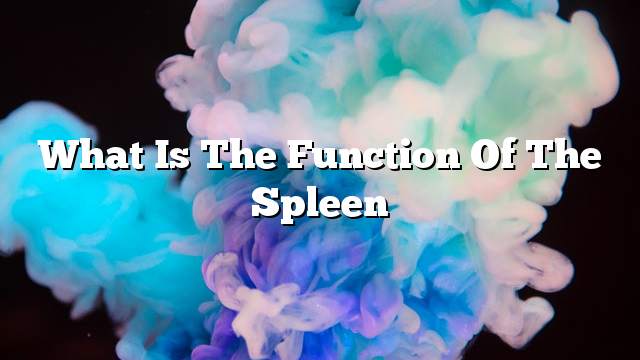Spleen
The spleen is an essential part of the immune system. It produces white blood cells that fight inflammation and make antibodies, store blood platelets and purify blood. The spleen is located at the top left of the abdomen at the level of ribs 9-11, size is the size of the hand grip, and the length of 10 to 12 centimeters, and the weight is from 150 to 200 grams.
The spleen is similar to the lymph nodes in terms of construction. It contains two main types of tissue as well as its solid fibrous envelope known as the spleen capsule. The tissues are as follows:
- White Pulp: It is a component of white blood cells, it forms part of the immune system because it is a lymphatic tissue.
- Red pulp: Is a spleen, composed of connective tissue known to contain many forms of white and red blood cells. The red pulp is made up of veins filled with blood.
Spleen functions
Functions of the white pulp
The functions of the white pulp include the blood test flowing through it. The pulp also produces and matures white blood cells containing B and T cells. B cells create antibodies to prevent infection, while T cells help identify and attack pathogens.
Functions of red pulp
The functions of the red pulp are as follows:
- Works in embryos as bone marrow work: It produces red blood cells, but usually ceases to do so after birth, but it may be repeated for certain patients.
- Get rid of microbes and red blood cells damaged and old: After 120 days of red blood cell life, these cells lose their ability to carry oxygen efficiently, which needs to be eliminated. This is done through a specific type of cell, known as phagocytic cells; phagocytic cells not only swallow red blood cells, Also ingest pathogens, including fungi, bacteria, and viruses.
- Stores about one-third of the body’s supply of platelets: Which are released in case of need, that is, when exposed to severe bleeding, and know platelets are the crumbs of cells that circulate in the bloodstream, and stop bleeding any injury to the person.
The importance of spleen
Although spleenectomy is more likely than others to become infected, although spleen may also have multiple functions, it is not a key member of life, it has been eradicated or is not functioning efficiently. Other members, Bone marrow and liver.
Diseases affecting the spleen
Diseases affecting the spleen include:
- Spleen rupture: Which can cause severe internal bleeding and serious; spleen is prone to rupture, and this is a medical emergency, and may show this tear only after exposure weeks.
- splenomegaly: Which occurs as a result of liver disease or for a viral cause or as a result of leukemia.
- Low platelet count: The enlarged spleen sometimes stores large amounts of platelets, which leads to the presence of a few in the bloodstream.
- Sickle cell disease: Is a type of inherited anemia that can lead to the destruction of many members including the spleen; in this disease prevents blood from flowing into the blood vessels.
Causes of splenectomy
There are many reasons that may require splenectomy, including:
- Carimmune thrombocytopenia (autoimmune thrombocytopenia purpura): Which causes a shortage of platelets in the bloodstream, which leads to exposure to hemorrhage, the fact that platelets help blood clotting, and the result of this state of the body to create antibodies to these plates, which causes destruction, and for treatment, it usually starts with drugs , And if the drugs do not succeed then resort to the eradication of the spleen, and this is the most common cause of eradication.
- Cancer: This disease may lead to the removal of the spleen not only for therapeutic purposes, but also for diagnostic purposes. The therapeutic purposes include treatment of cancer cells that fight infections, including lymphoma and certain types of leukemia.
- Genetics: There are many genetic diseases that may require the removal of the spleen, including thalassemia and sickle cell disease.
- other reasons: Sometimes the spleen may develop an inflammation that can only be cured by the removal of the spleen, or the blood supply may be cut off, or an artery may develop abnormally.
Cases requiring contact with the doctor after splenectomy
Cases that require contact with the doctor after the splenectomy include:
- Bleeding.
- Pain is not responsive to medication.
- Wound secretion of the wound.
- Increased redness of the wound area or large size.
- Increased abdominal distension.
- High and persistent temperatures.
- Chills.
- Shortness of breath and persistent cough.
- Persistent nausea or vomiting.
- Inability to eat or drink fluids.
